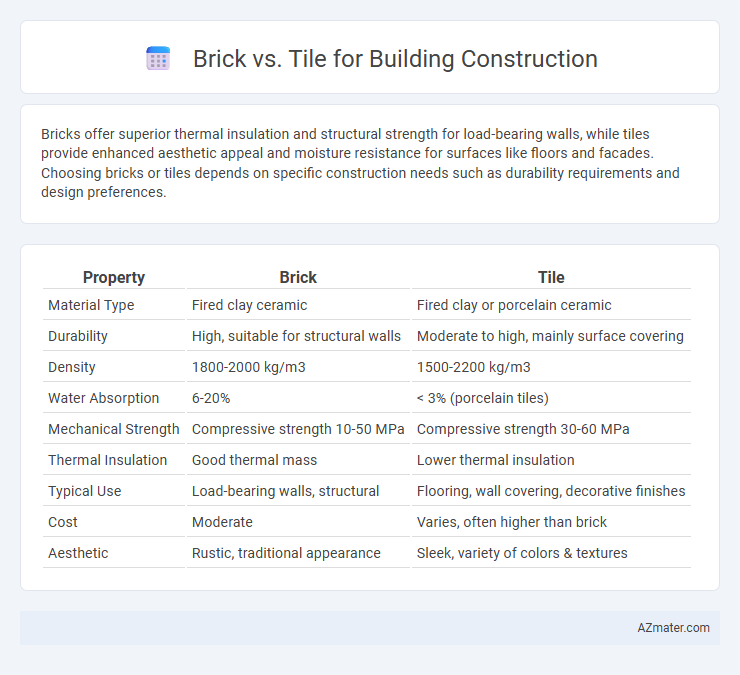Bricks offer superior thermal insulation and structural strength for load-bearing walls, while tiles provide enhanced aesthetic appeal and moisture resistance for surfaces like floors and facades. Choosing bricks or tiles depends on specific construction needs such as durability requirements and design preferences.
Table of Comparison
| Property | Brick | Tile |
|---|---|---|
| Material Type | Fired clay ceramic | Fired clay or porcelain ceramic |
| Durability | High, suitable for structural walls | Moderate to high, mainly surface covering |
| Density | 1800-2000 kg/m3 | 1500-2200 kg/m3 |
| Water Absorption | 6-20% | < 3% (porcelain tiles) |
| Mechanical Strength | Compressive strength 10-50 MPa | Compressive strength 30-60 MPa |
| Thermal Insulation | Good thermal mass | Lower thermal insulation |
| Typical Use | Load-bearing walls, structural | Flooring, wall covering, decorative finishes |
| Cost | Moderate | Varies, often higher than brick |
| Aesthetic | Rustic, traditional appearance | Sleek, variety of colors & textures |
Overview of Brick and Tile Construction
Brick construction involves the use of fired clay units that provide durability, thermal insulation, and aesthetic appeal, commonly used for load-bearing walls and facades. Tile construction primarily utilizes ceramic or porcelain units for flooring, roofing, and decorative surfaces, known for moisture resistance and easy maintenance. Both materials offer structural benefits, with bricks excelling in strength and tiles in surface finishing and weather protection.
Material Composition and Properties
Brick is primarily composed of clay or shale fired at high temperatures, resulting in a dense, durable material with high compressive strength and good thermal insulation properties. Tile, often made from ceramic, porcelain, or natural stone, has a denser, less porous structure that offers superior resistance to moisture, abrasions, and chemical exposure. The choice between brick and tile depends on the specific construction requirements, with bricks favoring load-bearing walls and tiles excelling in surface finishes or moisture-prone areas.
Structural Strength and Durability
Bricks offer superior compressive strength, making them ideal for load-bearing walls in building construction, while tiles primarily serve as surface finishes and lack structural support capabilities. Brick materials typically withstand high levels of stress and weathering, resulting in enhanced durability and longevity for foundational elements. Tile materials, such as ceramic or porcelain, provide resistance to moisture and wear but do not contribute significantly to the structural integrity of a building.
Thermal and Acoustic Insulation
Bricks offer superior thermal mass, retaining heat longer and providing effective temperature regulation in building construction. Tiles, while less efficient in thermal insulation, excel in acoustic insulation by dampening sound transmission through their dense and hard surfaces. Selecting bricks enhances energy efficiency, whereas tiles are preferred for reducing noise pollution in both residential and commercial structures.
Aesthetic Appeal and Design Versatility
Brick offers a timeless, classic aesthetic with rich textures and warm earth tones, enhancing traditional and rustic architectural styles. Tile provides greater design versatility with an extensive range of colors, patterns, and finishes, enabling modern, sleek, or intricate decorative applications. Both materials contribute unique visual appeal, but tile allows for more customized and detailed design options in building construction.
Cost Comparison and Budget Considerations
Brick offers higher durability and thermal insulation but comes with a higher upfront cost compared to tile, making it a more substantial initial investment. Tile provides a more affordable alternative with lower installation expenses and maintenance costs, ideal for budget-conscious projects. Cost considerations should include long-term benefits such as energy efficiency of bricks versus the quicker, more economical installation of tiles.
Installation Process and Labor Requirements
Brick installation in building construction typically demands skilled labor to ensure accurate alignment, mortar application, and curing time, with each brick laid individually requiring meticulous attention and longer installation periods. Tile installation, especially in flooring or wall cladding, involves surface preparation, precise cutting, and adhesive application, often using grout to fill gaps, which can be less labor-intensive than brickwork but requires expertise for pattern alignment and waterproofing. Labor costs for brick tend to be higher due to the complexity and duration of the process, whereas tile installation may be quicker but still demands precision to prevent future damage or uneven surfaces.
Maintenance and Longevity
Bricks offer exceptional durability and low maintenance, resisting weathering, pests, and fire, which makes them ideal for long-lasting construction. Tiles, while providing aesthetic versatility and ease of cleaning, may require more frequent repairs or replacements due to cracking or chipping over time. Choosing bricks enhances structural longevity with minimal upkeep, whereas tiles prioritize design flexibility at the cost of potentially higher maintenance.
Environmental Impact and Sustainability
Bricks, made from natural clay and shale, offer excellent thermal mass that enhances energy efficiency but require energy-intensive kiln firing during production, contributing to higher carbon emissions. Tiles, often produced from ceramic or slate, tend to have a lower environmental footprint with higher recyclability and less energy consumption in manufacturing. Both materials impact sustainability, but choosing locally sourced, responsibly manufactured options can significantly reduce the environmental impact of building construction.
Choosing Between Brick and Tile: Key Factors
Choosing between brick and tile for building construction depends on durability, thermal insulation, and aesthetic appeal. Bricks offer superior strength and load-bearing capacity, making them suitable for structural walls, while tiles provide enhanced moisture resistance, ideal for exterior cladding and decorative finishes. Cost-effectiveness and local availability also significantly influence the decision, with bricks typically being more affordable in traditional masonry projects.

Infographic: Brick vs Tile for Building Construction
 azmater.com
azmater.com